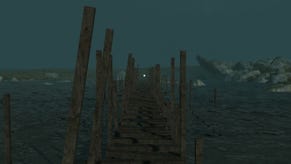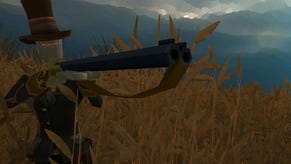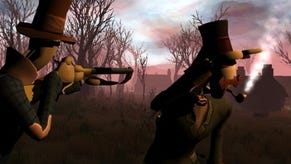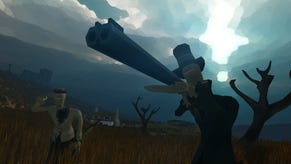Sir, You Are Being Hunted review
Ungentlemanly conduct.
Games have given us many iconic monsters, from Doom's Imps to Silent Hill's Pyramid Head. Yet indie developer Big Robot may have just created the most terrifying foe of all. The robots which stalk you across the bleak landscapes of Sir, You Are Being Hunted are, basically, Nigel Farage crossed with The Terminator.
Like UK Independence Party leader Farage, they embody a cartoonish, fantasy version of Englishness: a sort of tweedy, gentrified celebration of warm beer, milky tea and striding across moorlands with a shotgun. They also can't be bargained with. They can't be reasoned with. They don't feel pity, or remorse, or fear. And they absolutely will not stop, ever, until you are dead.
Sir, You Are Being Hunted is a survival game, but where most of the other entries in this suddenly overcrowded genre tend to be weighed down with systems - crafting, building, fortifying - Big Robot's entry has an arcade-style simplicity. You're trapped on an archipelago of five islands and must find 17 crystal fragments to power a mystical stone circle that can return you home.
It's a goal that is immediately understandable, but realising it is much harder than it seems. These fragments - visible by plumes of smoke - are always guarded by the insufferable Victorian robots who patrol the land, wittering on about the weather and taxes as they go. The robots also congregate near buildings, which act as the game's loot chests. Basically, everywhere you need to go, the robots have got there first.
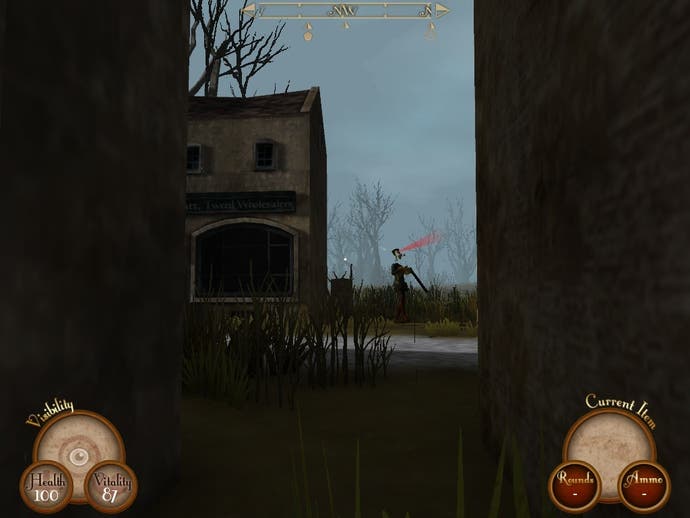
The nature of that loot is suitably skewed by the game's Anglican aesthetic. In amongst the mouldy boots and human skulls, you'll find bottles of sherry, flasks of tea and chocolate biscuits (which are both "usable" and "dunkable" according to the text descriptions). You'll also find things that can help you distract those beastly automatons, such as stones and bottles that can be thrown, as well as more elaborate diversions like alarm clocks and toy trains. There are also steel traps, which can hold a robot in place, and - if you're really lucky - weapons with which to destroy them.
On a moment-by-moment basis, then, it's a game about finding the things you need and then plotting how best to either sneak past the robots to get them (really hard) or defeating the robots in combat (also really hard). This is a really hard game. The only places where you can save your game are the stone circle on the central island and the boats which ferry you from one biome to another. Given that the entire game is procedurally generated, never offering the same landscapes or loot twice, the stakes are pretty high. Every time you find a useful item or weapon, let alone one of those essential crystals, your every step is measured against the potential for death and the permanent loss of whatever you have found since the last save.
The other major gameplay element is inventory management. As in Resident Evil, your inventory is a grid into which you must fit everything you want to carry. The bigger the object - rifles and shotguns, dead pheasants - the more space you need. Complicating matters is the fact that the crystals that you need to collect range from small shards to enormous chunks. Making space for them while still allowing yourself the objects you need to survive robot encounters takes a fair amount of thought.
It's a rare game that can make you laugh one moment and turn your bowels to ice with fear the next
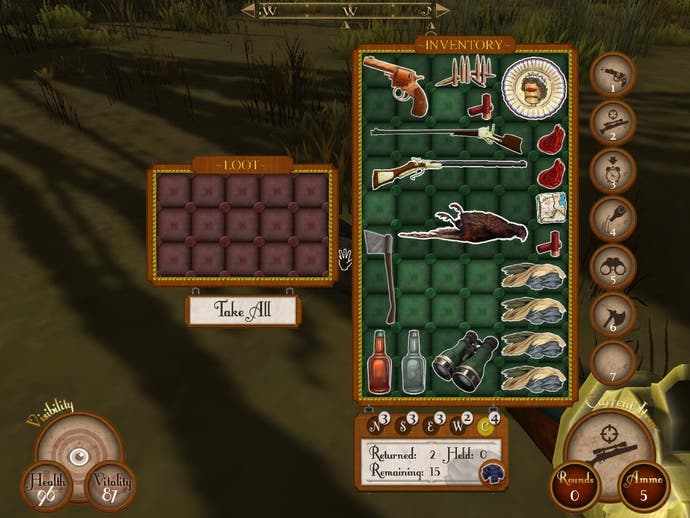
The game's essential simplicity means that it gets its hooks into you pretty quickly, since there are very few things to learn beyond the obvious need to stay out of sight whenever possible. However, with each crystal found and returned, the robot forces evolve, introducing new enemy types which ramp up the difficulty very quickly. Before long, the task of finding all 17 crystal pieces and getting them safely back to the central island has gone from enticing challenge to imposing grind. Not distractingly so, but there's just a little too much to collect, and a few too many trips back and forth across the islands, for Sir, You Are Being Hunted to sustain its early highs.
Stealth is functional, if not terribly elegant. A visibility meter offers a good indication of whether you're likely to be spotted or not, though it doesn't always match up with what's on-screen. The thinnest tufts of grass provide surprising cover, but it's also hard to gauge sometimes just what the field of vision of your enemies is. Add in their acute hearing - which has no handy display element to illustrate it - and you may find that the sneaky approach is hit-and-miss. I found an axe that solved most of my robot problems rather neatly by allowing me to charge them while they were reloading and smash them into scrap, even if it meant my stealth rating went through the floor.
What carries the game through is that aesthetic: silly, sinister and broadly satirical, with elements of everything from 2000AD to Monty Python stirred up in its guts. It's a rare game that can make you laugh one moment and turn your bowels to ice with fear the next. The robots are ridiculous but also genuinely threatening. You won't survive a direct encounter with more than a few of them, and even then it takes luck to emerge unscathed, so every time you hear their electronic babbling or spy their glowing red eyes in the distance, you'll instinctively freeze.
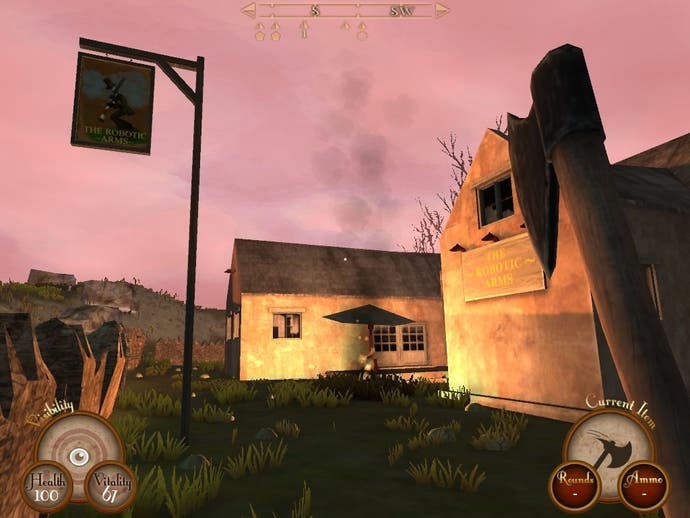
The game also looks quite lovely, despite visual assets that, taken on their own, are nothing to get excited about. Buildings are blocky, textures can be crude and foliage is flat. Put these together with some impressive lighting effects that really capture the feel of a drizzly sunrise or a chilly moonlit night, however, and the overall look can become rather beautiful. The landscapes are so striking that it's hard to believe they've been randomly generated rather than painstakingly posed by an artist. It's not uncommon for the scenery to look like something out of a Brontë adaptation - if the Brontës had had the foresight to include gun-toting robots in their stories.
Anyone who followed the game through its early-access period - which has now come to an end - will have seen how it has evolved in leaps and bounds. But it still has some way to go to truly fulfil its potential. The later hours of the game, in particular, feel like they need a little extra something to make finding those last few crystals into a gameplay crescendo instead of an exhausted stagger over the finish line. Even so, I've found myself going back to it, starting new worlds while juggling others in progress - largely because, even in the cramped indie survival game genre, there's nothing quite like Sir, You Are Being Hunted.


